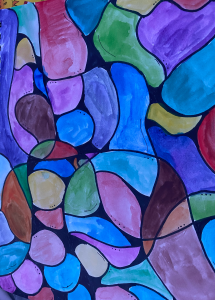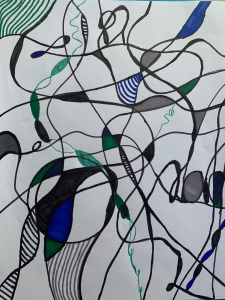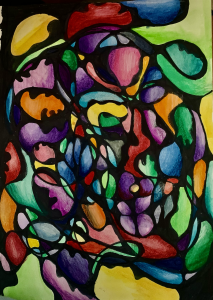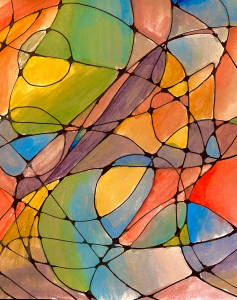 Looking for an art project that anyone can do at home?
Looking for an art project that anyone can do at home?
Consider neurographic art!
Pattie Hoban-Rich’s high school Mixed Media class recently completed a project that combines art, art therapy, science and psychology. And it’s one more way faculty are inventively engaging their in-person and remote students in creative projects.
“I picked neurographic art to do with my Mixed Media students because I love to ‘cross curriculum’ whenever possible,” she said. “It’s a wonderful chance to infuse other subject areas with art. It is a great project to do virtually. It is fun and relaxing to do.”
 Subconscious mind and drawing connections
Subconscious mind and drawing connections
Neurographic art is a simple way to work with the subconscious mind through drawing, Mrs. Hoban-Rich explained. This creative method stimulates new neural pathways by combining art and psychology. Simply stated, connected neurons process information received. enabling people to interact, experience emotions and sensations, create memories and enable learning. The art technique was created by Russian psychologist, creativity entrepreneur and architect Pavel Piskarev in 2014.
Neurographic artists know this type of art is a way to offer someone to  transform one’s stress and fear by drawing freeform lines and then later using a specific algorithm to transform the stress into a beautiful work of art.
transform one’s stress and fear by drawing freeform lines and then later using a specific algorithm to transform the stress into a beautiful work of art.
The algorithm is simple:
- Use a felt tip pen to draw a long looping or criss-crossing/scribble-like line on your paper.
- If you want to do it “the art therapy way,” think of a problem or issue you are facing while you draw the line.
- Don’t try to draw something, just let it be a line.
- Find any sharp corners where lines cross or turn and round those, filling in the gap with ink.
- Add “field lines” that extend to the edges, then round any new corners.
- You can also add shapes that overlap the lines if you want.
- Add color (you can blend colors or do shading)
- Draw smaller lines that overlap and round corners again.
- You can turn some of the lines into something recognizable or keep it abstract.
 Try this at home: A relaxing way to make connections
Try this at home: A relaxing way to make connections
“It’s used as an art therapy technique that helps people make connections,” said Mrs. Hoban-Rich. “Many people find it meditative or relaxing to do.”
When creating their intersections and sharp angles, students were encouraged “to be aware sense of recreating that wholeness, of softening the edges of the harsh thoughts, and merging with intentions and greater knowing….being open to unlimited possibility and perspective,” to stay mindful of the art project’s therapeutic benefit.
“Neurographic art really helps to clear your mind and it is for all ages,” Mrs. Hoban-Rich added. “I think the results have been amazing. Each individual artwork is as unique as the artist who created it!”
To see more photos, visit the district’s Facebook page.
